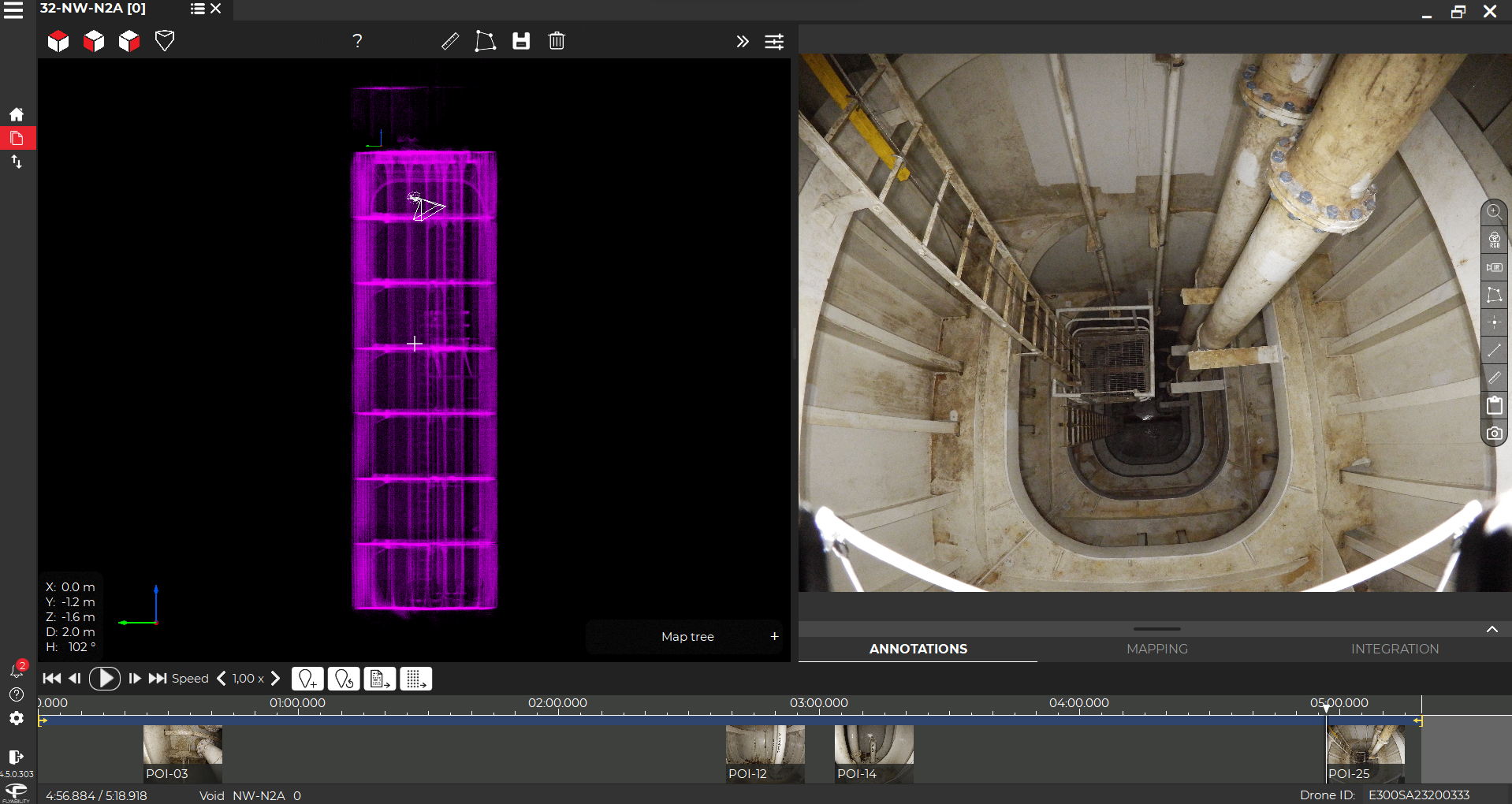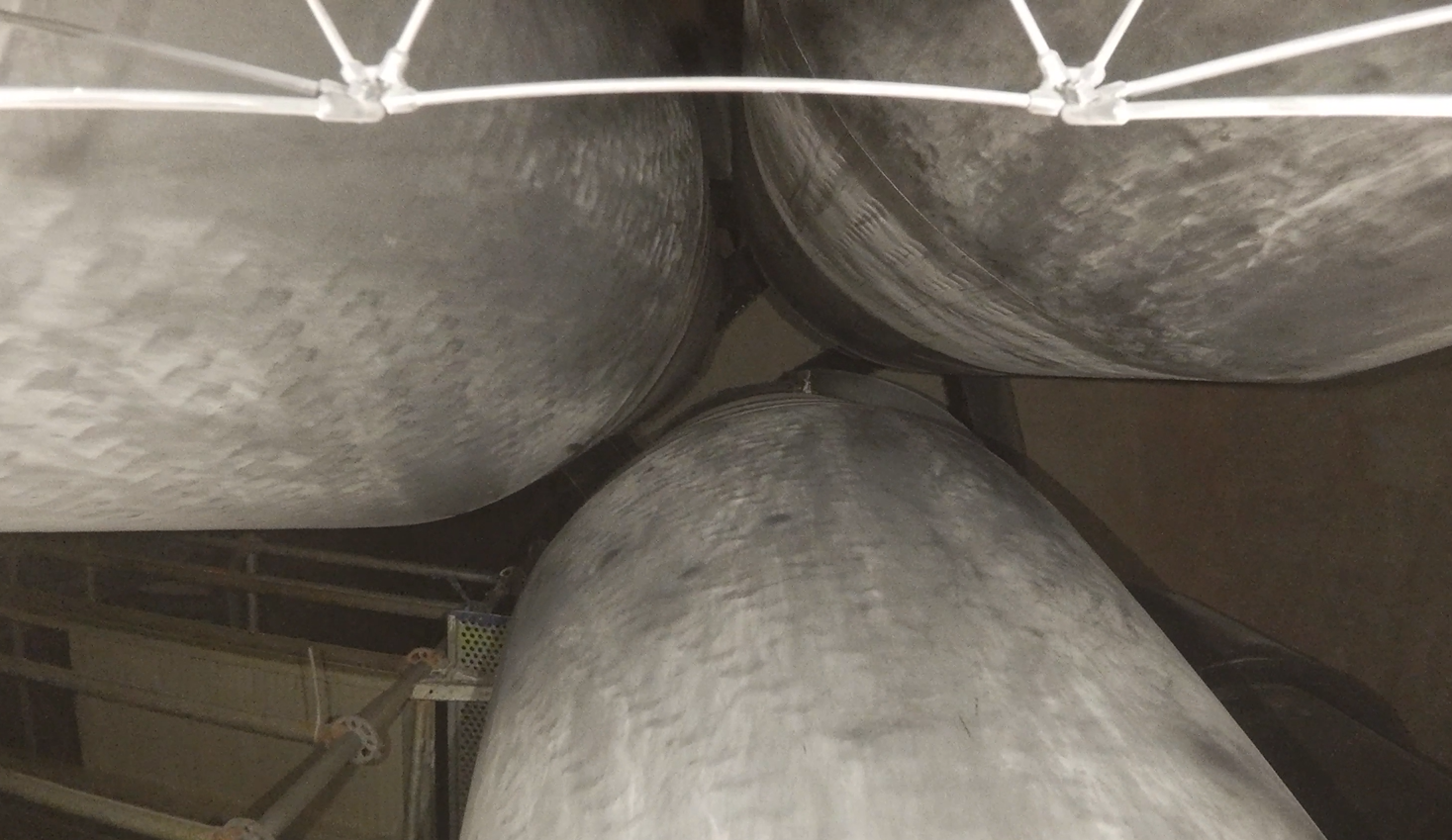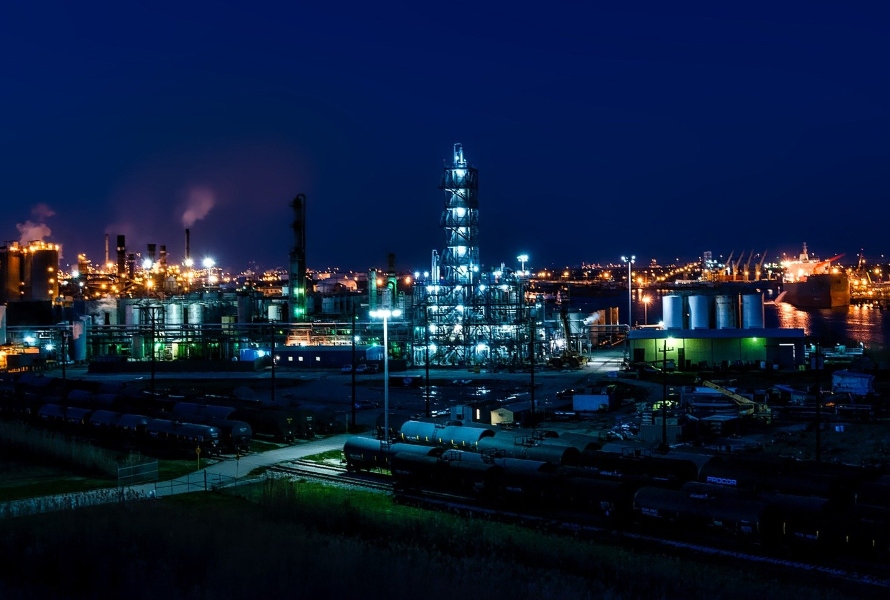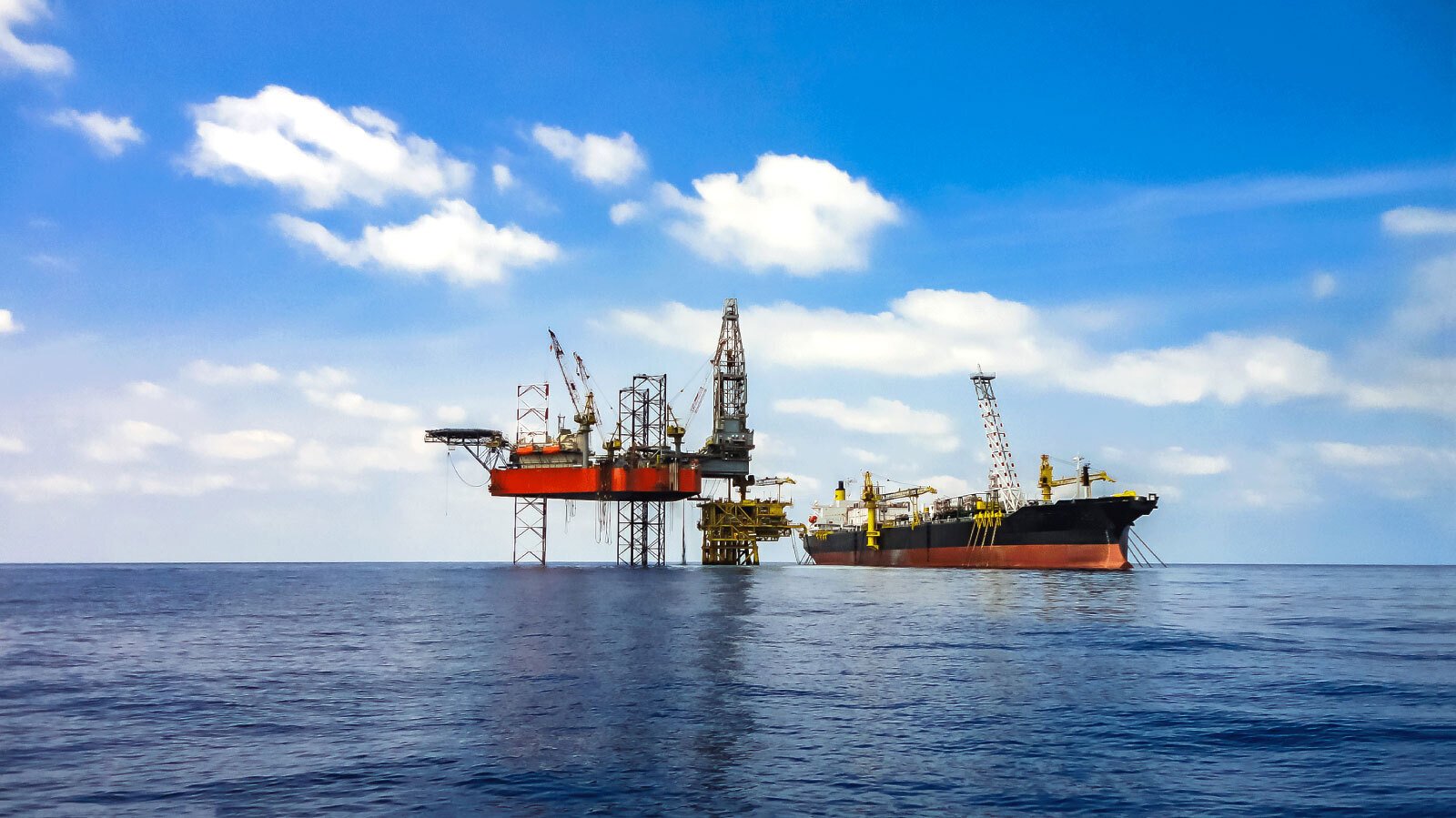
Successful oil & gas operations should be safe, efficient, and streamlined - without unnecessary downtime.


3D model of an oil tank showing the recorded points of interest captured with Elios 3 4K camera.
Close up:
Weld examination
Close up:
Bold condition
Close up:
Pitting defect highlighted by the oblique lighting system.
BENEFITS
Substantially reduce the cost of oil and gas inspections while maintaining workplace safety
Reduce risks
Perform regular inspections remotely from a safe distance and quickly address asset issues.
Reduce costs
Maximize uptimes and save on equipment & labor costs with remote data collection by drone.
Collect reliable data
Get detailed data in the most confined spaces and quickly pinpoint asset anomalies.
APPLICATIONS
Make informed decisions on maintenance requirements and the frequency of inspections
Mechanical integrity analysis
Undertake drone inspections for asset integrity management inside confined oil and gas including refineries, oil tanks, and operational vessels such as FPSOs, bulk carriers, and tankers.
Preventive maintenance
Quickly and regularly get visual data on the internal condition of an asset to better plan for maintenance shutdowns and reduce unplanned downtimes.
Fly in hard-to-reach confined spaces
Perform remote analysis and evaluation of hard-to-reach confined structures such as pipe racks, storage tanks, vessels, cracker units, and chimneys.
ASSETS
Access to advanced drone capabilities for a range of applications in confined and hazardous spaces
Offshore Rigs, Jackups, and FPSOs
Checking the inside of ballasts and tanks for possible anomalies of the structures on offshore rigs, FPSOs, drilling ships or oil tankers.
FCC and cokers
Manage critical production units with refinery drone inspections on assets such as Fluid Catalytics Cracking and Cokers.
Storage tanks
Identify for cracks and corrosion on rafters, walls, and roof sections of storage tanks during integrity assessment inspections by performing close visual inspection beyond the line of sight.
Chimneys / smokestack
Perform a General Visual Inspection to detect cracks and anomalies on the inside of a sky-high chimney during an oil refinery drone inspection.
IN ACTION
Capture every corner of the most confined assets, from a safe location with drone asset management
Use Flyability indoor drones to assess the integrity of oil and gas assets and, if required, plan for repairs before vulnerabilities become a problem.

| Speed | Ease of use | Accuracy |
|
Deploy a drone on demand without the need for elaborated safety procedures or complex scaffolding. |
During the flight, navigate through the 3D live map. Locate the drone precisely inside the asset & visualize its exact trajectory. |
Get detailed 3D insights, with 100% coverage. |

Look for signs of defects such as coating conditions, damage, corrosion, or cracks. Ensure systematic collection of data throughout the tank and complete the inspection in a fraction of the time vs. traditional methods.
| Safety | Efficiency | Quality |
| No confined space entry. No confined space entry. The inspection is performed from the deck. |
<2 hours inspection process, incl. 3 flights of 6 min each to map the entire ballast (15 meters long and 12 meters deep). |
High definition video and photos across all POIs identified. |

Use a drone to perform visual inspections inside FCC units where the air quality is poor and the visibility is difficult for human eyes. Inspect all parts periodically to ensure the unit is safe for continued use.
| Safety | Speed | Cost efficiency |
| No human entry. | 4 hours inspection process vs 2.5 days on average. | +$100k saved in downtime, 170 work hours saved. |

Use a drone to inspect system areas that are difficult to reach at short notice, without any costs for scaffolding. Check the condition of welds, drains and inlets, corrosion coatings, screw connections and other components of the tank.
| Safety | Speed | Cost efficiency |
|
No work at height (20 m high), no manned entry. |
6 min flight to map the entire tank (~90 m diameter). |
96% cost reduction vs traditional inspection method (from eliminating scaffolding and reducing downtime). |

A drone can help identify potential climbing hazards, find structural damage, and help inspectors understand the tools they need prior to climbing. Once this information has been gathered, the inspector can follow up and address the issues revealed in the data - if any.

Inspect a regenerator without having to rely on scaffolding or rope access, thanks to the innovative power of drones. Easily detect damage in the structure and components of the asset and capture beautiful 3D models to pinpoint the exact location of interest points and keep them monitored over time without having to send people to inspect them.
| Safety | Speed | Cost efficiency |
|
Avoid work at height and human entry. |
6 min flight to map the entire asset. |
Eliminate scaffolding, inspect in a team of only two, and reduce asset downtime. |
Related Products
Elios 3
Indoor drone for inspection, mapping and surveying
Built to keep humans safe, the Elios 3 features a unique collision-tolerant cage that helps inspectors to collect data in confined spaces that have been inaccessible in the past.
Relying on the power of computer vision and LiDAR mapping, Elios 3 allows pilots to navigate inside industrial assets building a real-time 3D view of the drone’s environment and trajectory.

TESTIMONIALS
What our customers say about Elios
“Among the many use cases we identified for robotics at Total, confined spaces inspection is probably the one that gave us the best satisfaction. This has been possible thanks to the Flyability Elios, which the Total inspectors pilot day after day. Whether for planned or unplanned shutdowns, this is a fast decision-making tool which enhances our safety and the availability of our assets.”
UAVs & Robotics Officer, Total Energies
Unmanned Operations Manager, Premium Inspection & Testing
EPC Preject Manager, GE Oil & Gas
CASE STUDIES
Learn how oil & gas companies are using indoor drones
Learn More
Interested to learn more?
Subscribe to receive more stories about Flyability drones in the Oil & Gas industry.
Frequently Asked Questions
In order to operate a drone, do you have to be an engineer, an NDE inspector or a piping inspector?
No, it is not required, but you should always be aware of the regulations concerning commercial drone operations in your area before flying. Anyone who has completed the introductory training can fly an Elios drone. Traditionally our clients work in teams of two when performing inspections, using one pilot and one inspector who can analyze the data on the spot. With this approach, each person can focus on their area of expertise.
How do I train my team?
Flyability has put in place a complete certification and training program that takes drone pilots from discovering the particularities of piloting a drone indoors BVLOS (Beyond Visual Line of Sight), to being able to perform the most difficult indoor inspection missions. The certification tests the pilots on their ability to assess the difficulty of a mission and puts their own piloting skills into perspective. Our training courses are defined and provided by professional pilots with extensive mission track records using Elios drones. Every bit of theory you will learn is backed-up by practical exercises that are directly applicable to your everyday job as a pilot. Operators following our training courses receive a valuable professional certification, reflecting their proficiency at using Elios drones.
Do I need to adapt my Standard Operating Procedures (SOPs)?
Asset owners are responsible for deciding whether to modify their SOPs to accommodate the use of drones. Nevertheless, SOPs provide a method to communicate the process changes to employees. As they no longer rely on humans to enter confined spaces for inspection, most of our customers update SOPs to take the drone into consideration.
Can a drone be used as a formal inspection tool?
Several clients have conducted formal inspections using our products that have been approved by classification societies. You can read more about an example in this article: https://www.flyability.com/articles-and-media/can-a-drone-be-used-as-a-formal-inspection-tool
However, it’s important to note that drones can't permanently be recognized as a formal inspection tool, since inspectors are agnostic to specific tools. Rather, inspectors can approve a given tool in a specific inspection when they see the data it can produce.
How do you process inspection data?
Once your mission is complete, you can simply connect Elios to your computer using the USB port fitted on the top of the drone to import all data into Inspector, our companion software.
After retrieving the flight data, you have immediate access to a high resolution point cloud of your assets that you can visualize in Inspector. You can then review your POIs and document your inspection by taking notes in the POIs, making measurements, and exporting your data as a report.
Does Flyability keep your data safe from cyber attack?
As long as the user does not manually connect to a WiFi network, there is no physical link between the Elios system and the internet—ensuring complete data safety.
In addition, Flyability only collects data in one instance: when the drone is armed while the tablet on the GCS is connected to the internet. In these cases, we collect the unit ID—which is encrypted and can only be read by Flyability—as well as the time of flight and the firmware version. Operators are notified of this data collection and have the option to opt-out.
For more information on data safety, please consult the following link:
Are drones intrinsically safe?
ATEX is the European certification given to equipment tested and approved to be intrinsically safe.
Elios drones are not ATEX rated nor are they intrinsically safe. We believe it is not possible for a drone to be intrinsically safe (none to date).
To fly in an environment that might require intrinsically safe equipment, you will need to perform a procedure to neutralize the environment,as you would do when performing a manned inspection. Despite this, you still have a lot to gain when performing the inspection with a drone instead of a human. For example, you can use nitrogen to neutralize the asset and send in a drone right away. If you do the same for a manned inspection, the inspector will have to carry a breathing apparatus and you will need to deploy bystanders, which is much more complicated,dangerous, and costly.
For more information on this subject, please follow read this article:
https://www.flyability.com/articles-and-media/are-drones-intrinsically-safe
Can I fly Elios drones outdoors?
Flyability drones can fly outdoors in ATTI mode to inspect outdoor assets. However, it is not recommended to do so as it is much harder to control the drone in ATTI mode. This use case is reserved to experienced pilots only. Keep in mind that flying outdoors is subject to airspace regulations, unlike indoor flights.
Should I insource or outsource drone-based inspections?
It depends on your usage and the regulations in place. Some industries may require a qualified and certified inspector to perform an inspection. In case you would like to outsource, there are service providers that use Elios drones all around the world.
For more information on deciding whether to insource or outsource for your drone needs, consult the following links:
Insourcing versus outsourcing your industrial inspection drone program
Drone Inspections Insourcing vs Outsourcing Your Drone Inspection Program
What is the size of the smallest defect that Elios drones can spot?
With Elios 2 & 3, you can capture images with a Ground Sampling Distance of 0.18 mm/pixel when standing at 30 centimeters from the surface you inspect. With this accuracy, you can easily spot defects that are a few millimeters wide, such as small cracking patterns in the walls or a hole inside of a silo.
Learn more about the visual data you can collect with the Elios 2:
Drones Camera Resolution: Three Metrics You Should Know About
Is dust a blocker for drone-based inspections?
Industrial indoor spaces are often full of dust, which makes First-Person View aircraft navigation difficult. Elios drones feature a dust-proof lighting system that allows you to fly inside dirty, dusty places without losing sight of your objective. And for extreme cases, you can navigate inside assets relying solely on the 3D Live Map created by LiDAR and displayed instantly in Cockpit.







